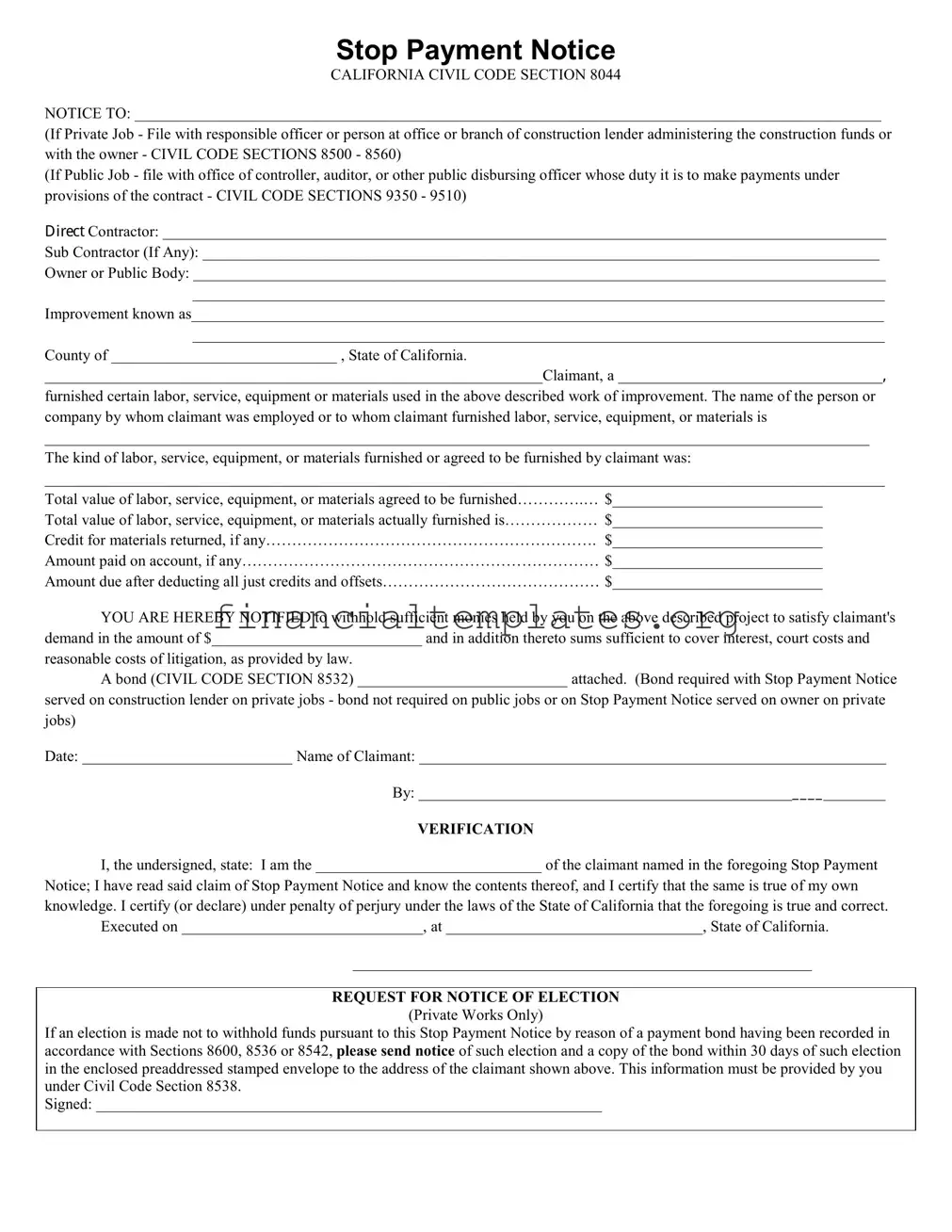Stop Payment Notice
CALIFORNIA CIVIL CODE SECTION 8044
NOTICE TO: ________________________________________________________________________________________________
(If Private Job - File with responsible officer or person at office or branch of construction lender administering the construction funds or with the owner - CIVIL CODE SECTIONS 8500 - 8560)
(If Public Job - file with office of controller, auditor, or other public disbursing officer whose duty it is to make payments under provisions of the contract - CIVIL CODE SECTIONS 9350 - 9510)
'LUHFW Contractor: _____________________________________________________________________________________________
Sub Contractor (If Any): _______________________________________________________________________________________
Owner or Public Body: _________________________________________________________________________________________
_________________________________________________________________________________________
Improvement known as_________________________________________________________________________________________
_________________________________________________________________________________________
County of _____________________________ , State of California.
________________________________________________________________Claimant, a __________________________________
furnished certain labor, service, equipment or materials used in the above described work of improvement. The name of the person or company by whom claimant was employed or to whom claimant furnished labor, service, equipment, or materials is
__________________________________________________________________________________________________________
The kind of labor, service, equipment, or materials furnished or agreed to be furnished by claimant was:
____________________________________________________________________________________________________________
Total value of labor, service, equipment, or materials agreed to be furnished………….… $___________________________
Total value of labor, service, equipment, or materials actually furnished is……………… $___________________________
Credit for materials returned, if any………………………………………………………. $___________________________
Amount paid on account, if any…………………………………………………………… $___________________________
Amount due after deducting all just credits and offsets…………………………………… $___________________________
YOU ARE HEREBY NOTIFIED to withhold sufficient monies held by you on the above described project to satisfy claimant's demand in the amount of $___________________________ and in addition thereto sums sufficient to cover interest, court costs and
reasonable costs of litigation, as provided by law.
A bond (CIVIL CODE SECTION 8532) ___________________________ attached. (Bond required with Stop Payment Notice
served on construction lender on private jobs - bond not required on public jobs or on Stop Payment Notice served on owner on private jobs)
Date: ___________________________ Name of Claimant: ____________________________________________________________
By: ________________________________________________BBBB ________
VERIFICATION
I, the undersigned, state: I am the _____________________________ of the claimant named in the foregoing Stop Payment
Notice; I have read said claim of Stop Payment Notice and know the contents thereof, and I certify that the same is true of my own knowledge. I certify (or declare) under penalty of perjury under the laws of the State of California that the foregoing is true and correct.
Executed on _______________________________, at _________________________________, State of California.
___________________________________________________________
REQUEST FOR NOTICE OF ELECTION
(Private Works Only)
If an election is made not to withhold funds pursuant to this Stop Payment Notice by reason of a payment bond having been recorded in accordance with Sections 8600, 8536 or 8542, please send notice of such election and a copy of the bond within 30 days of such election in the enclosed preaddressed stamped envelope to the address of the claimant shown above. This information must be provided by you under Civil Code Section 8538.
Signed: _________________________________________________________________

